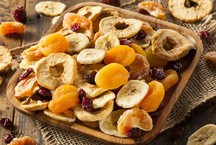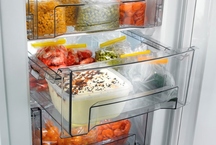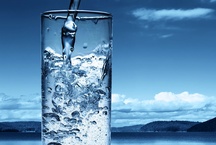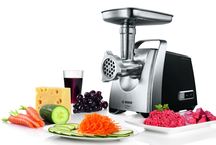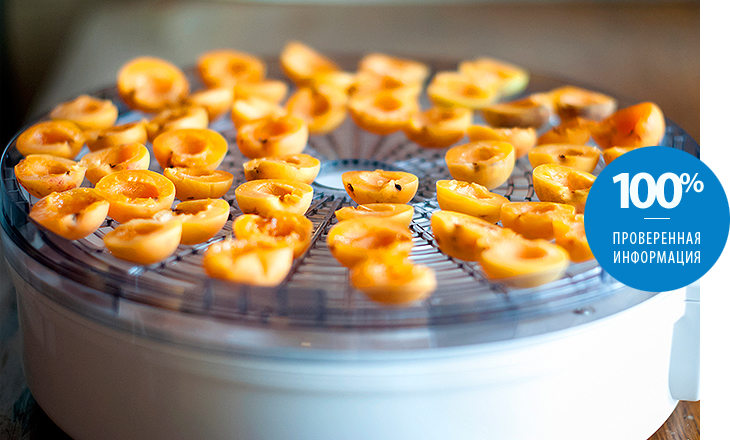
When summer comes to an end, it's time to stock up the remains of a rich dacha harvest for the winter. Canning is a classic way that has one major drawback: during preservation, most vitamins die. Is there a way to preserve the healthy elements contained in fruits and vegetables? Of course, and this is drying. If you do not want to turn an apartment into a huge dryer of gifts from your own garden, purchase a special device for this. When buying a dryer for vegetables and fruits, the consumer often hopes for chance, because these devices appeared on the market relatively recently. We will help you choose a dryer for vegetables and fruits to suit your needs.
The advantages of an electric dryer over conventional drying in the open air
- Not required a lot of space;
- Better and faster processing, regardless of the weather conditions on the street;
- The ability to use at home, in the country and wherever there is an electrical outlet;
- The function of temperature selection for various products;
- Hygiene (do not have to eat dusty and insect-infested dry fruits).
What are the dryers for vegetables and fruits?
Convective
The evaporation of moisture in products occurs under the action of hot air streams, which is created by a heating element and forcibly injected with a special fan. Such dryers for vegetables and fruits are the most common and popular due to their efficiency, reliability and low price.
But there are minuses. Products during processing lose their natural color (darken), and it is not possible to fully preserve vitamins.
Heating
It also uses the effect of convection, but due to the natural movement of warm air. In simple words - TEN is, and there is no fan. There are very few similar models on the market, and, if possible, convective varieties are preferable.
Infrared
The method of drying is similar to the natural exposure to sunlight, only a special heater is used as the source. Heat energy is transferred directly to the products. At the same time moisture from their structure is removed, and the natural color is preserved. Dryers for vegetables and fruits with infrared heating show the best results, economical and easy to operate. When drying in an infrared dryer, more beneficial vitamins are stored than in a convective one. Among the shortcomings - the high price, a long drying process and a small representation on the market.
Tablecloths-dryer
Compact and mobile version of the infrared emitter. Such devices consume very little energy, are easily twisted, can be used as alternative sources of heat for various purposes. The main disadvantage: a small working surface area, respectively, low productivity.
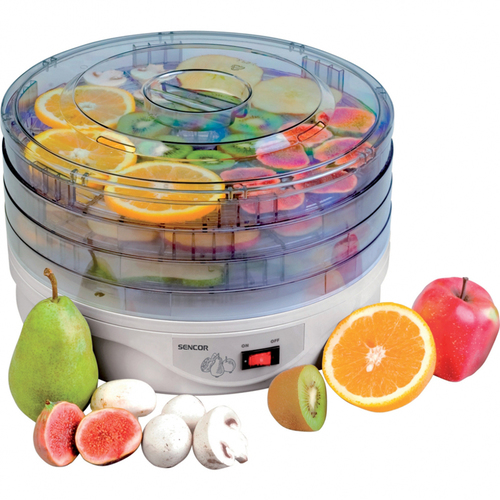
The main criteria for the selection of dryers for vegetables and fruits
It depends on how well you approach the selection of the required parameters of the electric dryer - whether it will fully meet your needs and become an indispensable assistant in the harvesting season - or it will be thrown into the depths of the storeroom and there will be no use collecting dust.
Capacity
This parameter mainly depends on the number and diameter of the trays. The classic version - dryers with 3-5 levels - is suitable for a standard family and will allow to dry several kilograms of products in one session.For those who plan to recycle a serious harvest, copies of 6-8 tiers and even more will be relevant. There are models that support the simultaneous use of 15-20 pallets, capable of handling up to 15 kg of fresh fruit.
Many manufacturers purposefully classify their dryers by total volume, but it is important to understand that the stated figure does not always correspond to reality. Focusing on high gaps between the levels makes sense when loading the overall or whole products (for example, mushrooms). If it is planned to use mainly cut raw materials that are laid out on the surface in one layer, it will be more important - how many pallets are included and their size (area)?
Power
The most "weak" varieties of dryers for fruits and vegetables consume 150-250 watts. They are designed for making very small portions, are suitable for small families and are rather a sort of “toy” in order to occasionally please children with various chips or preserve what they don’t eat, but it’s a pity to throw out. Considered optimal models on 350-600 watts. They are quite roomy, effective, and the meter is not particularly strain. The most powerful dryers can consume up to 1 kW. Such a dryer for fruits and vegetables is chosen when there is a need to dry a lot and in fewer cycles.
Sellers in stores and some "experts" often state that the higher the power, the faster the drying. In reality, the power-capacity relationship is more relevant. The time of a single session in most cases is practically the same.
Temperature conditions
Since the purpose of drying is to preserve its useful properties and vitamin composition in the finished product, the process is carried out at low temperatures, close to natural. For convective devices characteristic modes: Low (gentle) 30-40 ° C Medium (average) 45-55 ° C and High (high) 60-75 ° C. The first option is relevant for greens and herbs, the second and third - for vegetables, fruits, berries, mushrooms, meat, fish. In some models, the choice is fixed (2-3 positions), in others it is with an extended, smooth adjustment. Infrared dryers sufficient temperature range of 40-60 ° C. If the budget allows, it is better to choose a dryer for vegetables and fruits with several temperature regimes in order to be able to dry different products.
Body material
There are two main versions, although there are also combined ones.
- Metal. Durability, reliability and durability of products made from this material is beyond doubt. But at the same time, they have considerable weight, thermal insulation properties are clearly not their ridge (heated), and a rather “stern” appearance is unlikely to inspire the owners of city apartments. Here for the cottage or a private house - not bad.
- Plastic. A more common and practical option that can suit everyone. The weight of such dryers is small, they are easy to assemble / disassemble, easy to clean, the number of pallets can increase. And if the latter is also transparent, it becomes possible to control the drying process without opening the device. When buying cheap models, it is important to pay attention to the quality and “odorousness” of plastic.
Control type
Electronics with touch keys and the display is convenient, less prone to contamination and allows for more accurate adjustment. Mechanics traditionally reliable.
Tray location
- Vertical. Characteristic for most convection dryers. Pallets are installed one on the other and covered with a lid. Heating can be carried out from below (the most common option) or above. In the first case, large volumes are available, in the second - the design is more durable and easy to maintain, since moisture and particles of the products do not fall on the heating unit.
- Horizontal. This design of household electric driers borrowed from professional dehydrators.Trays are put forward by analogy with baking sheets, each of them can be removed without touching the others. And if you remove it completely, it becomes possible to model the working chamber space for placing dimensional objects (for example, cans for the fermentation of yogurt). The heater is located on the back wall.
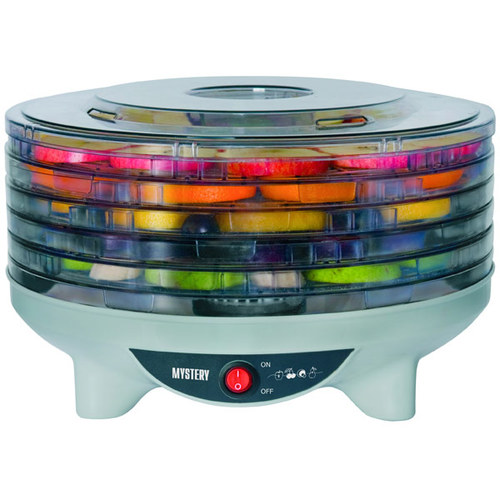
Extra options
When choosing a dryer for vegetables and fruits, pay attention to the additional options that the device makes working with it even more enjoyable:
- The possibility of cooking pastila, drying meat, fish. Pleasant bonuses, especially if their presence does not greatly affect the price, and they will really be in demand;
- Hot air system in pallets. In the standard version trays are made in the form of a sieve. In the nearest to the heater, the temperature is higher, in the remote ones it is lower. Therefore, they have to periodically change places. In the most advanced models, air is supplied independently to each of the levels. The result is uniform drying, and smells do not mix;
- Auto-off timer. The process of dehydration is long, so it is more convenient to automate it, so as not to worry about the products being overdried;
- Pallet material. Metallic durable and reliable, but can warm unevenly. Plastic is easier, more practical and cheaper;
- overheat protection. Makes instrument operation safer and prolongs service life;
- The ability to adjust the height of the pallets. Actual for drying mushrooms without chopping.
The best manufacturers of dryers for vegetables and fruits
- Elite and the highest quality dryers for vegetables and fruits are represented on the domestic market by brands. Ezidri, Rawmid, Rommelsbacher. Their excellent performance, reliability and functionality are highly appreciated by consumers. But to pay for the pleasure will have a lot - 9-18 thousand rubles.
- The undoubted favorites of the average price range (4-8.5 thousand rubles) are the infrared dryers Dachnik. Among convective models, the best and most popular ones are the affordable analogues of expensive New Zealand Ezidri - the domestic one. Voltera and Belarusian BelOMO.
- Economy class (up to 3 thousand rubles) is widely and adequately represented by Russian dryers "Breeze", "Rotor", "Hot Wind", "Ryzhik". There are some good models from the Chinese trademark mates Supra, Scarlett, Smile.
And about the best models of dryers for vegetables and fruits, read more in our ranking.
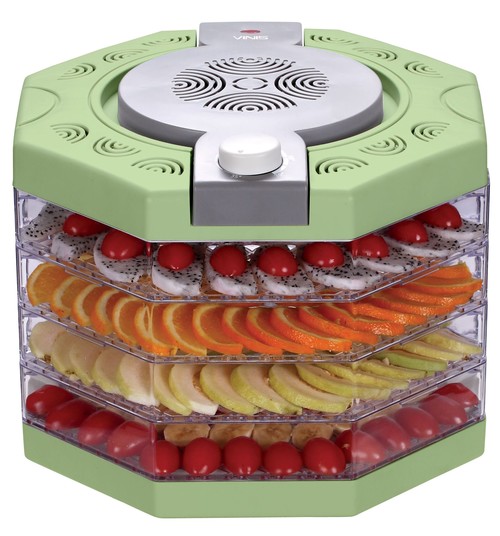
General recommendations
As many will use the dryer for the first time, we will give some tips that will help to increase its service life and improve the quality of dry vegetables and fruits.
- If the pallets at the dryer are solid (not lattice) - they can be covered with baking paper. So you protect the tray from stains.
- Wash the dryer after each use! Remember that it is better not to use chemical agents when cleaning it, since, due to the complexity of the design, their residues may not be removed when flushing.
- At the beginning of the drying set the heat, and towards the end gradually lower it. So fruits and vegetables will be better preserved, and their taste will be just amazing!
- Do not overload the pallets, trying to quickly dry everything - so they are processed unevenly, and the device will overheat. It is necessary to leave a small distance between the pieces.
- In the process of drying rearrange the pallets, changing their places. So vegetables and fruits will be cooked more evenly.
- Do not put different vegetables and fruits in the dryer with the standard vertical air distribution at the same time, otherwise you risk getting carrot-like kiwi.
- Ready dried fruits and dried vegetables should be stored in a dry place in fabric or paper bags or in glass jars.
- Dried fruits and dried vegetables can be restored by placing them in a bowl with warm water for 1-2 hours.
- Carefully read the instructions and follow the manufacturer's recommendations. After all, often a problem or an unimportant result of drying is associated with non-observance of the elementary rules of operation.
We wish you good shopping and delicious wintering!
